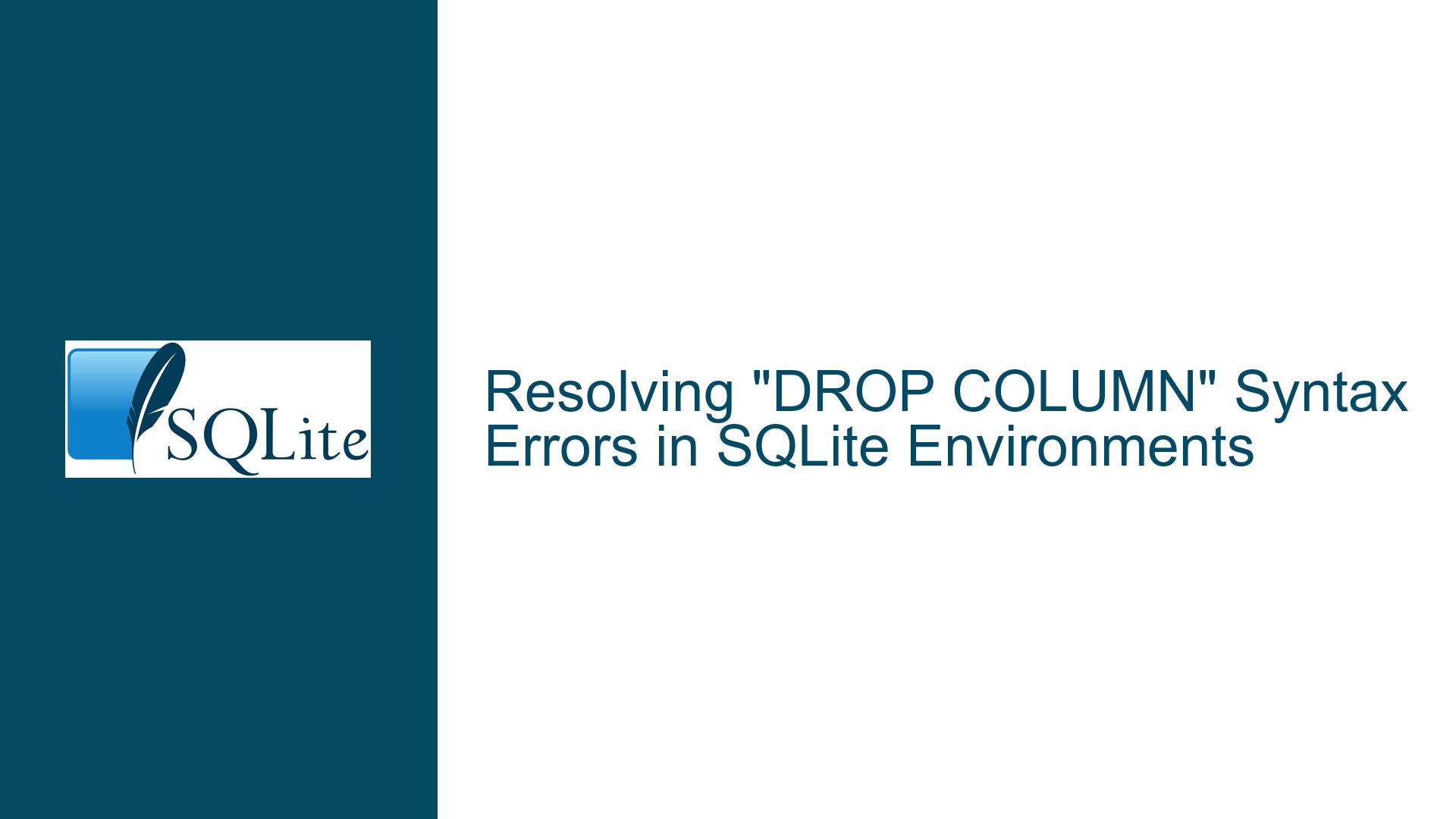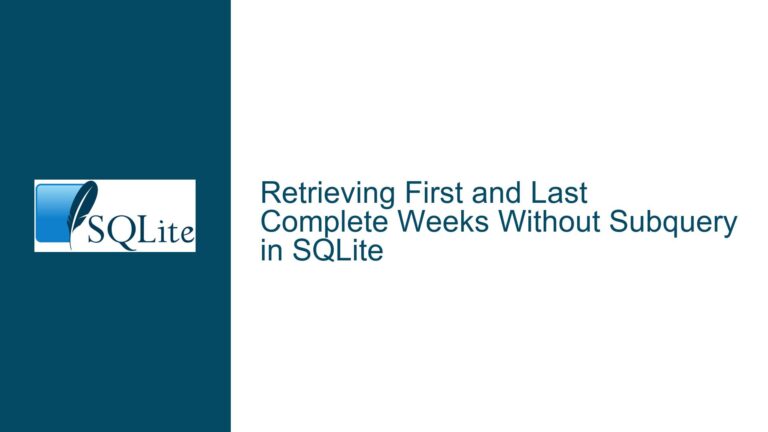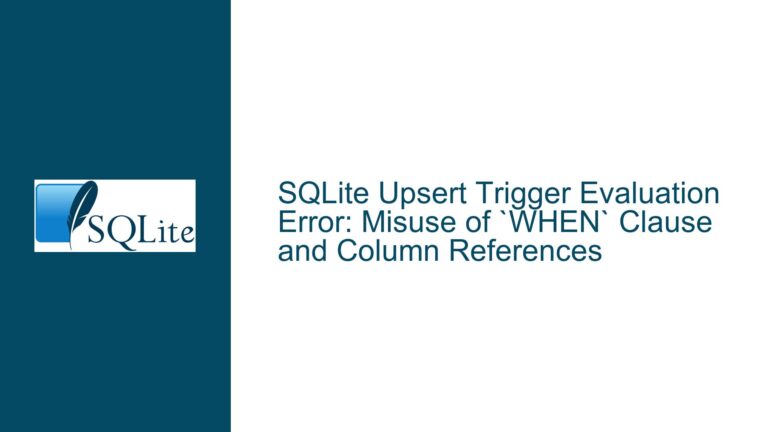Resolving “DROP COLUMN” Syntax Errors in SQLite Environments
Issue Overview: Incompatibility Between SQLite Versions and Third-Party Tools
The core problem arises when executing the ALTER TABLE ... DROP COLUMN command in SQLite-compatible tools or libraries, resulting in syntax errors despite the same command working in the SQLite command-line interface (CLI). This discrepancy stems from version mismatches between the SQLite library embedded in third-party tools and the SQLite CLI. The DROP COLUMN operation was introduced in SQLite version 3.35.0 (2021-03-12). Tools or libraries that bundle older SQLite versions will reject this syntax, while newer CLI installations will accept it. The GitHub link provided in the original discussion confirms that SQLiteBrowser (as of March 2023) used a pre-3.35.0 SQLite version, causing the failure. Similarly, JavaScript libraries like better-sqlite3 may bundle outdated SQLite binaries depending on their build configuration. The root cause is not a flaw in the SQL syntax itself but the absence of support for DROP COLUMN in older SQLite implementations.
Possible Causes: Version Mismatches and Embedded Library Conflicts
Cause 1: Outdated SQLite Library in Third-Party Tools
Third-party tools such as SQLiteBrowser or libraries like better-sqlite3 often embed a specific SQLite version during their compilation. If these tools were built against SQLite versions older than 3.35.0, they will lack support for the DROP COLUMN clause. For example, SQLiteBrowser’s GitHub issue history shows that it historically linked against SQLite 3.34.x, which predates the DROP COLUMN feature. Similarly, JavaScript libraries may use precompiled SQLite binaries that are not updated to match the latest SQLite releases.
Cause 2: Incorrect Assumptions About Tool-Specific SQLite Versions
Developers often assume that third-party tools automatically use the system-wide SQLite installation. This is incorrect. Tools like SQLiteBrowser or language-specific libraries (e.g., better-sqlite3 in Node.js) statically link their own SQLite binaries. Even if the system’s SQLite CLI is version 3.35.0 or newer, the tool’s internal library remains outdated unless explicitly updated by the tool’s maintainers.
Cause 3: Silent Fallback to Legacy ALTER TABLE Behavior
In SQLite versions prior to 3.35.0, the ALTER TABLE command only supports renaming tables or adding columns. Attempting to drop a column triggers a syntax error because the parser does not recognize the DROP COLUMN clause. Older tools do not emit warnings about unsupported features; they simply reject the syntax. This creates confusion when the same command works in newer CLI environments.
Troubleshooting Steps, Solutions & Fixes: Diagnosing and Resolving Version Conflicts
Step 1: Verify SQLite Versions Across Environments
Action: Determine the SQLite version used by each tool or library.
CLI Check: Run sqlite3 --version in the terminal.
In-Tool Check: Execute SELECT sqlite_version(); within the tool (e.g., SQLiteBrowser’s “Execute SQL” tab) or via library methods (e.g., better-sqlite3’s db.prepare("SELECT sqlite_version()").get()).
Outcome: If the reported version is below 3.35.0, the tool/library cannot execute DROP COLUMN.
Step 2: Update or Reconfigure Third-Party Tools
Action: Force third-party tools to use a newer SQLite library.
For SQLiteBrowser: Recompile the tool with SQLite 3.35.0+ or use a patched build. Check the tool’s GitHub repository for updated binaries.
For better-sqlite3: Reinstall the library with the --build-from-source flag and ensure the system has SQLite 3.35.0+ development headers installed. Example:
npm rebuild better-sqlite3 --build-from-source
For Other Tools: Consult documentation to override the embedded SQLite library or request updates from maintainers.
Step 3: Use a Manual Column Drop Workaround
Action: Implement the legacy table-rebuild method to simulate column removal.
Procedure:
- Create a new table without the target column:
CREATE TABLE atr_new (remaining_col1, remaining_col2); - Copy data from the old table:
INSERT INTO atr_new SELECT remaining_col1, remaining_col2 FROM atr; - Drop the old table:
DROP TABLE atr; - Rename the new table:
ALTER TABLE atr_new RENAME TO atr;
Caveats: This method requires disabling foreign key constraints and rebuilding indexes/triggers manually.
Step 4: Validate Tool-Specific SQLite Bindings
Action: For programming libraries, explicitly link against a modern SQLite build.
Example in Node.js with better-sqlite3:
- Install the latest SQLite3 amalgamation:
wget https://sqlite.org/2023/sqlite-amalgamation-3420000.zip unzip sqlite-amalgamation-3420000.zip - Rebuild the library with custom SQLite sources:
npm config set better_sqlite3.include /path/to/sqlite-amalgamation npm rebuild better-sqlite3
Step 5: Monitor SQLite Version Adoption in Tools
Action: Track tool-specific updates to identify when DROP COLUMN becomes supported.
Resources:
- SQLiteBrowser’s releases page
better-sqlite3CHANGELOG- SQLite’s official changelog
Step 6: Use Conditional SQL Execution
Action: Programmatically check for DROP COLUMN support before executing the command.
Example in JavaScript:
const db = require('better-sqlite3')('test.db');
const sqliteVersion = db.prepare('SELECT sqlite_version()').get()['sqlite_version()'];
const [major, minor, patch] = sqliteVersion.split('.').map(Number);
if (major > 3 || (major === 3 && minor >= 35)) {
db.exec('ALTER TABLE atr DROP COLUMN atr_kline_15_BTCUSDT');
} else {
// Fallback to table-rebuild method
}
By systematically addressing version mismatches, recompiling tools with modern SQLite builds, and employing backward-compatible workarounds, developers can resolve DROP COLUMN syntax errors while maintaining compatibility across environments.






